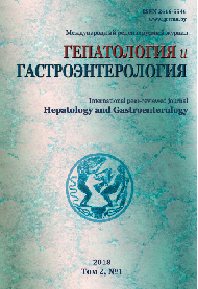ANTI-VIRUS TREATMENT OF PATIENTS WITH CHRONIC HEPATITIS C: ERADICATION OF THE VIRUS HAS BEEN REACHED, THE RISC OF COMPLICATIONS REMAINS
Abstract
Background. Chronic hepatitis C (CHC) remains an unresolved medical and social problem, despite high effectiveness of modern antiviral therapy (MAT). Objective of the study was to assess the virological and morphological effectiveness of various schemes of MAT for CHC.
Materials and methods. 122 patients with CHC received MAT. Fibrosis of the liver was assessed by FibroTest before and after the treatment. The patients were divided into the following groups according to MAT schemes: group I (51) – pegylated interferon-α (PEG-IFN) and ribavirin (24-48 weeks); group II (34) – PEG-IFN, ribavirin and sophosbuvir (12 weeks); group III (37) – without PEG-IFN (12-week regimen): sophosbuvir and ribavirin (2); direct antiviral drugs (DAD): sophosbuvir and lepidasvir (20); sophosbuvir and daсlatasvir (9); sophosbuvir and daсlatasvir with added ribavirin (6) for 24 weeks.
Results. In group I a stable virologic response (SVR) was obtained in 78.4% patients, in group II – in 97.0%, in group III – in 97.1%. After the treatment, a decrease in fibrosis was achieved in 57.1% and 50.0% of the 60 examined patients from groups I and II correspondingly, including F3-F4 – in 34.3% vs.37.5%. In 5.7% and 16.7% of the patients, respectively, there was an increase in fibrosis. A proportion of people with A3 decreased from 41.6% to 9.7% after the treatment with a significant increase in A0 (up to 84.6%).
References
1. Kabinet Ministriv Ukrainy. Derzhavna cilova socialna programa profilaktyky, diagnostyky ta likuvannja virusnyh gepatytiv na period do 2016 roku. Zatverdzhena vid 29.04.2013 № 637 [State target social program of prevention, diagnosis and treatment of viral hepatitis for the period till 2016. Approved by April 29, 2013 № 637] [Internet]. Available from: http://zakon3.rada. gov.ua/laws/show/637-2013-%D0%BF. (Ukrainian).
2. Ministerstvo Ohorony Zdorovja Ukrainy. Unifikovanyi klinichnyi protokol pervynnoi, vtorynnoi (spetsializovanoi) medychnoi dopomohy doroslym ta ditiam «Virusnyi hepatyt C». Zatverdzhen vid 02.04.2014 № 233 [Unified clinical protocol of primary, secondary (specialized) medical care for adults and children «Viral hepatitis C». Approved by 02.04.2014 № 233] [Internet]. Available from: http://health-ua.com/article/4502-unfkovanijklnchnij-protokol-pervinno-vtorinno-spetcalzovano-medichno-dopom. (Ukrainian).
3. Ministerstvo Ohorony Zdorovja Ukrainy. Unifikovanyj klinichnyj protokol pervynnoi, vtorynnoi (specializovanoi), tretynnoi (vysokospecializovanoi) medychnoi dopomogy «Virusnyj gepatyt S u doroslyh». Zatverdzhen vid 18.07.2016 r. № 729 [Unified clinical protocol of primary, secondary (specialized), tertiary (highly specialized) medical care «Viral hepatitis C in adults». Approved by July 18, 2016, № 729] [Internet]. Available from: http://mtd.dec.gov.ua/images/dodatki/2016_729_VGC/2016_729_YKPMD_VGC.pdf. (Ukrainian).
4. European Association for Study of Liver. EASL Recommendations on Treatment of Hepatitis C 2015. J. Hepatology. 2015;63(1):199-236. doi: 10.1016/j.jhep.2015.03.025.
5. European Association for Study of Liver. EASL Recommendations on Treatment of Hepatitis C 2016. J. Hepatology.2017;66(1):153-194. doi: 10.1016/j.jhep.2016.09.001.
6. Wang LS, D’Souza LS, Jacobson IM. Hepatitis C − A clinical review. J. Med. Virol. 2016;88(11):1844-1855. doi: 10.1002/jmv.24554.
7. El-Serag H, Kunik M, Richardson P, Rabeneck L. Psychiatric disorders among veterans with hepatitis С infection. Gastroenterology. 2002;123(2):476-482.
8. Kowala-Piaskowska A, Słuzewski W, Figlerowicz M, Mozer-Lisewska I. Early virological response in children with chronic hepatitis C treated with pegylated interferon and ribavirin. Infection. 2007;35(3):175-179.
9. Dementeva NE, Kalinina OV, Znojko OO, Beljakov NA, Zhebrun AB. Cirkuliruyushaya rekombinantnaya forma virusa gepatita C RF1_2k/1b: Problemy diagnostiki terapii [The circulating recombinant form RF2k/1b of Hepatitis C virus: problems in diagnostics and therapy]. VICH-infekciya i immunosupressii. [HIV Infection and Immunosuppressive Disorders]. 2016;8(1):42-52. (Russian).
10. Telegin DJe, Kozko VM, Bondar OJe, Dubinska GM, Mynak JeN, Munteanu M. Interferon-oposeredkovana regresija fibrozu pid chas protyvirusnoi terapii hronichnogo gepatytu S pry riznyh variantah polimorfizmu gena IL28B [Іnterferon-mediated regression of fibrosis during antiviral therapy for chronic hepatitis C in different variants of IL28B gene polymorphism]. Aktualna infektolohiia [Actual Infectology]. 2014;1(2):14-18. (Ukrainian).
11. Chen Yi Mei SLG, Thompson AJ, Christensen B, Cunningham G, McDonald L, Bell S, Iser D, Nguyen T, Desmond PV. Sustained virological response halts fibrosis progression: A long-term follow-up study of people with chronic hepatitis C infection. PLoS One. 2017;12(10):e0185609. doi: 10.1371/journal.pone.0185609.
12. Uojima H, Murakami S, Nakatani S, Hidaka H, Takeuchi A, Tanaka Y, Inoue T, Yamane K, Kubota K, Nakazawa T, Shibuya A, Tanaka Y, Koizumi W. Late Relapse after a Sustained Virologic Response at 24 Weeks after Treatment with Daclatasvir and Asunaprevir Combination Therapy for Chronic Hepatitis C Virus Genotype 1b Infection with Liver Cirrhosis. Intern. Med. 2018;57(7):951-956. doi: 10.2169/internalmedicine.9671-17.
13. Gospodarskyj IJa, Gavryljuk NM, Prokopchuk OV. Mozhlyvosti protyfibroznoi terapii pislja eliminacii virusu gepatytu C [Possibility of antifibrotic treatment after elimination of hepatitis C virus]. Infectious diseases [Infectious Diseases]. 2018;1:14-20. doi: 10.11603/1681-2727.2018.1.8667. (Ukrainian).
14. Matsuura K, Tanaka Y. Host genetic variations associated with disease progression in chronic hepatitis C virus infection. Hepatol. Res. 2018;48(2):127-133. doi: 10.1111/hepr.13042.
15. Li DK, Ren Y, Fierer DS, Rutledge S, Shaikh OS, Lo Re V, Simon T, Abou-Samra AB, Chung RT, Butt AA. The shortterm incidence of hepatocellular carcinoma is not increased after hepatitis C treatment with direct-acting antivirals: An ERCHIVES study. Hepatology [Internet]. 2017 Dec. Available from: https://aasldpubs.onlinelibrary.wiley.com/doi/abs/10.1002/hep.29707.
16. Innes H, Barclay ST, Hayes PC, Fraser A, Dillon JF, Stanley A, Bathgate A, McDonald SA, Goldberg D, Valerio H, Fox R, Kennedy N, Bramley P, Hutchinson SJ. The risk of hepatocellular carcinoma in cirrhotic patients with hepatitis C and sustained viral response: role of the treatment regimen. J. Hepatol. 2018, 68(4): 646-654. doi: 10.1016/j.jhep.2017.10.033.
17. Mettke F, Schlevogt B, Deterding K, Wranke A, Smith A, Port K, Manns MP, Vogel A, Cornberg M, Wedemeyer H. Interferon-free therapy of chronic hepatitis C with direct-acting antivirals does not change the short-term risk for de novo hepatocellular carcinoma in patients with liver cirrhosis. Aliment. Pharmacol. Ther. 2018;47(4):516-525. doi: 10.1111/apt.14427.


















1.png)






